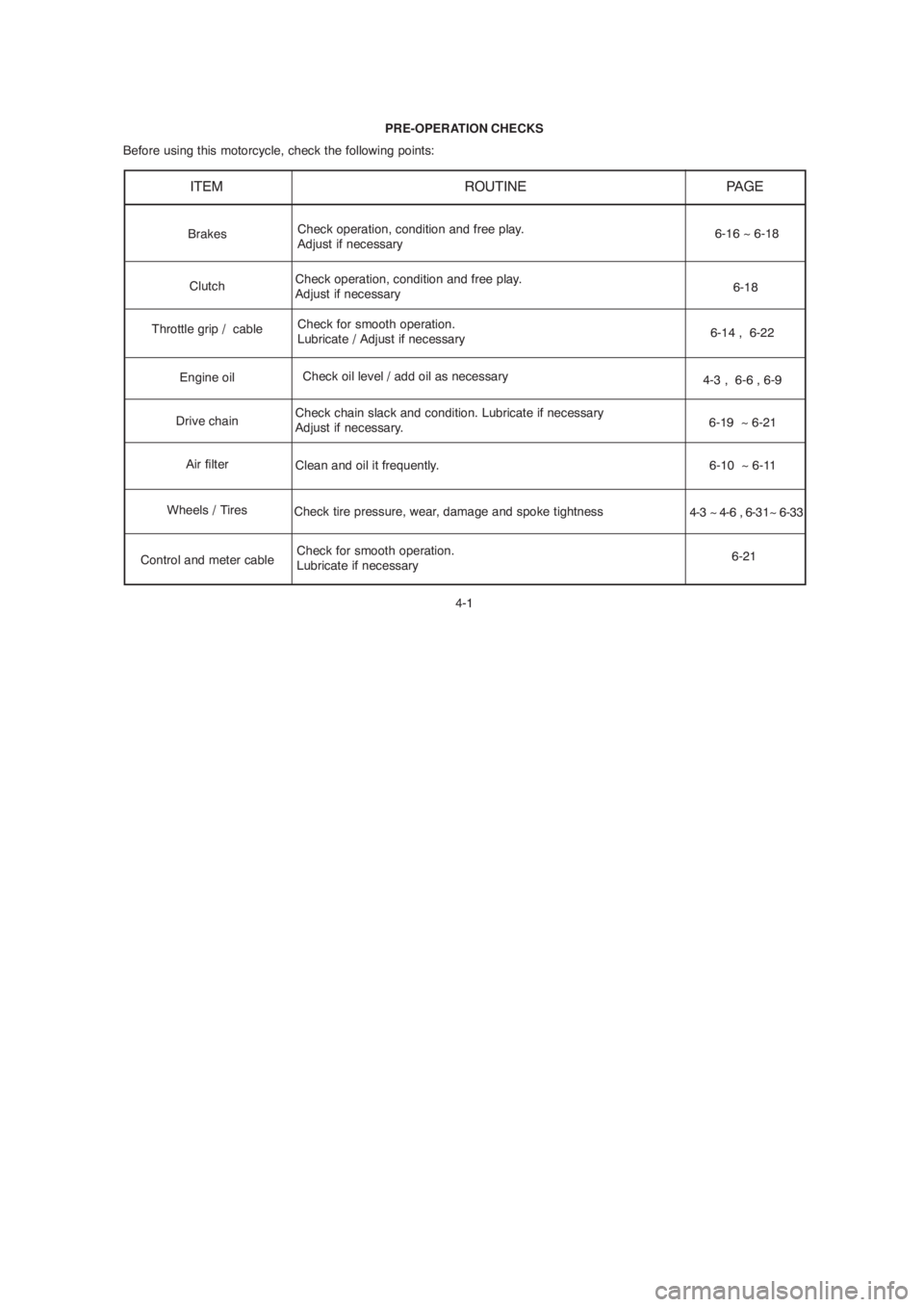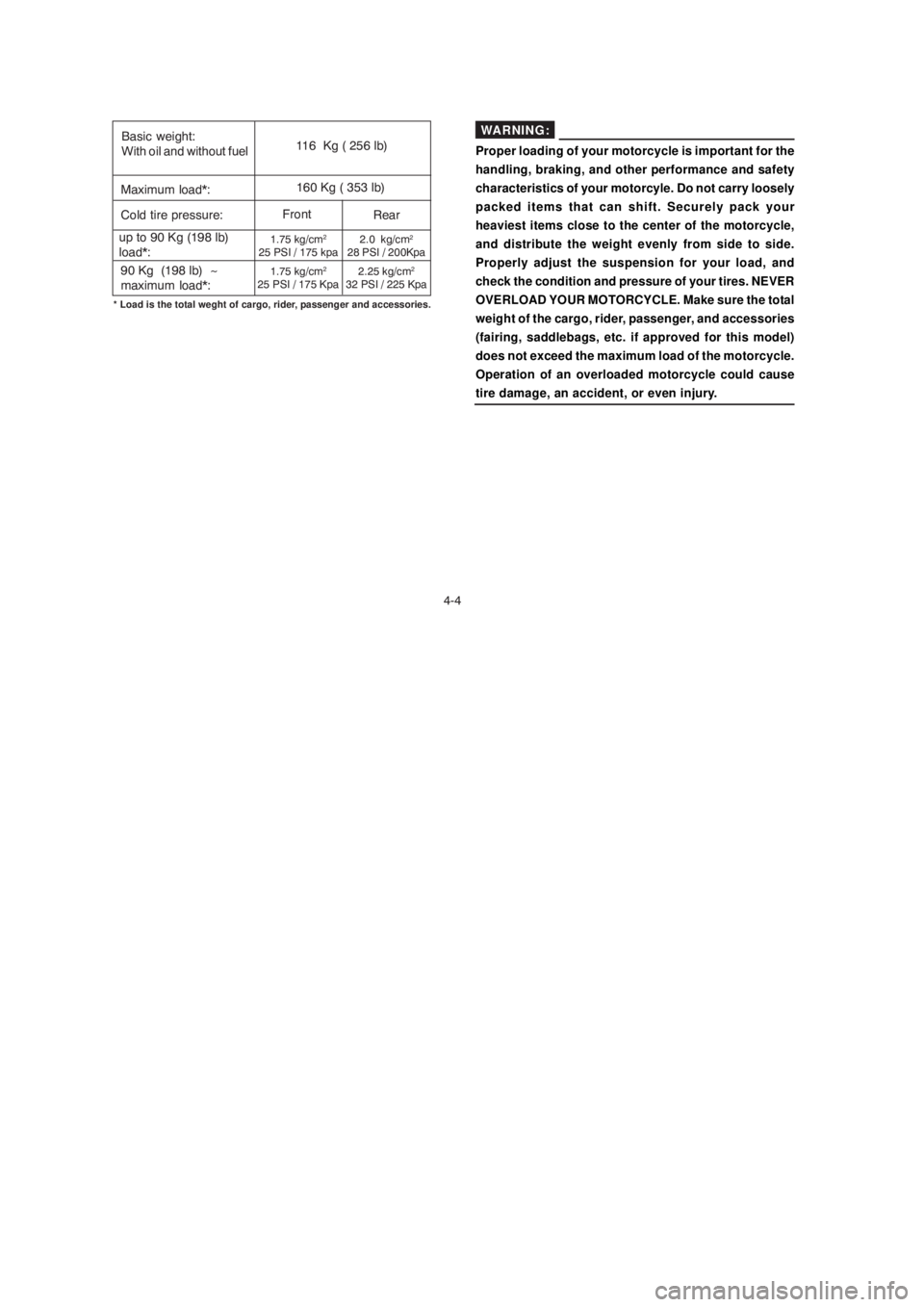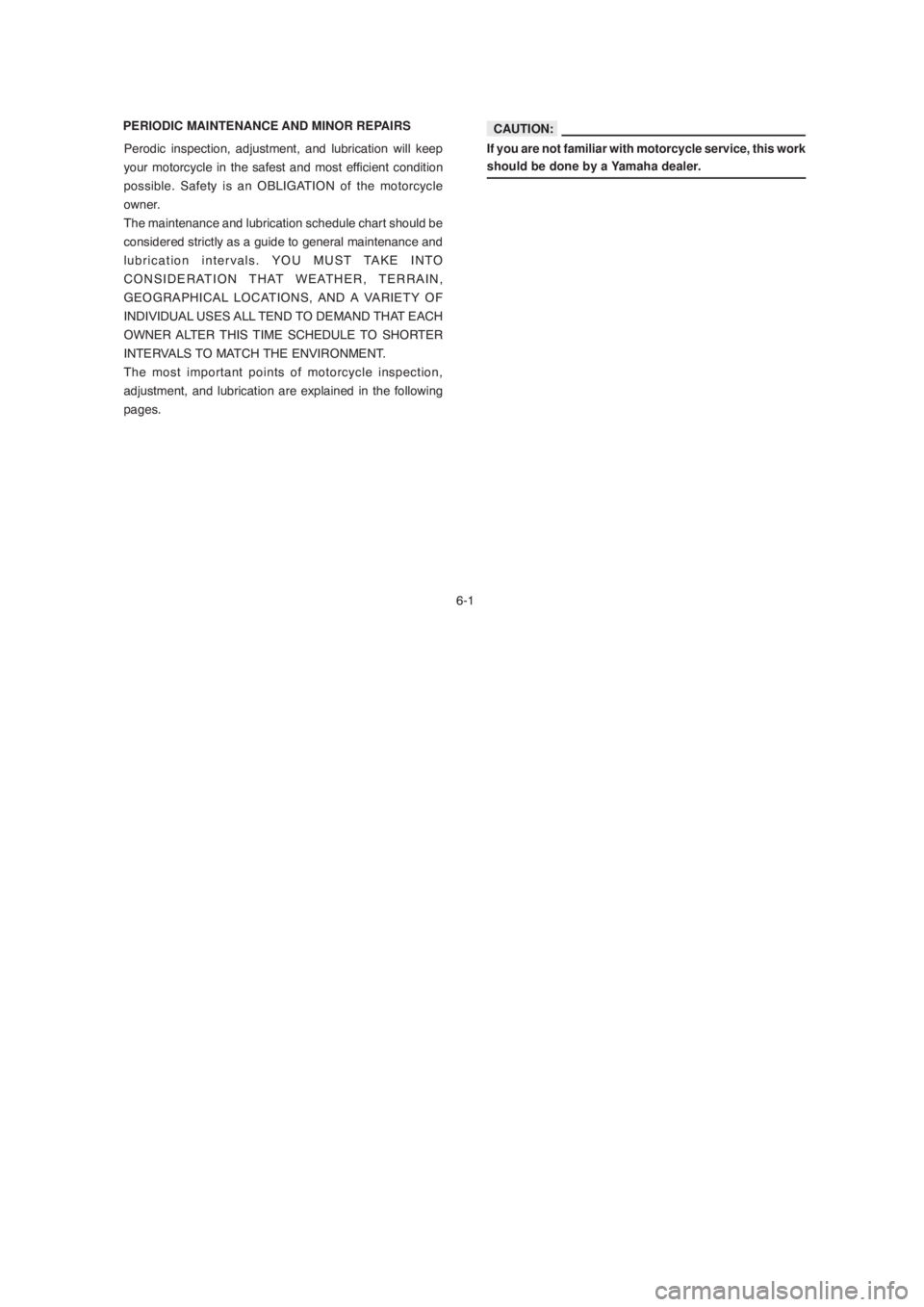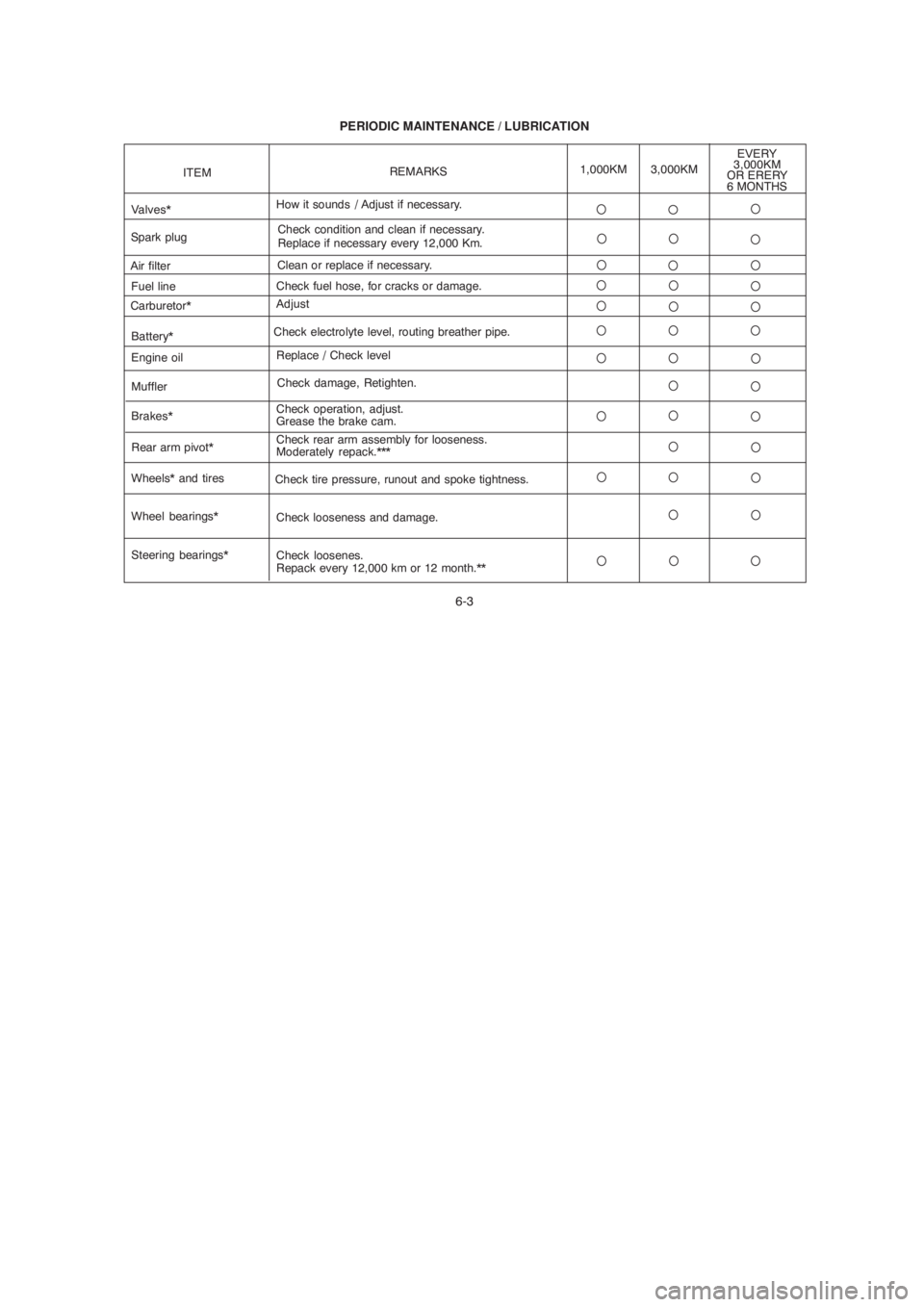air condition YAMAHA YBR125 2004 Owners Manual
[x] Cancel search | Manufacturer: YAMAHA, Model Year: 2004, Model line: YBR125, Model: YAMAHA YBR125 2004Pages: 83, PDF Size: 3.16 MB
Page 29 of 83

PRE-OPERATION CHECKS
Before using this motorcycle, check the following points:
ITEM ROUTINE
PAGE
Check operation, condition and free play.
Adjust if necessary
Clutch
Throttle grip / cableCheck for smooth operation.
Lubricate / Adjust if necessary
Check oil level / add oil as necessary
Engine oil
Drive chainCheck chain slack and condition. Lubricate if necessary
Adjust if necessary.
Air filter
Control and meter cableCheck tire pressure, wear, damage and spoke tightness
Check for smooth operation.
Lubricate if necessary6-16 ~ 6-18
6-14 , 6-22
4-3 , 6-6 , 6-9
6-19 ~ 6-21
6-10 ~ 6-11
4-3 ~ 4-6 , 6-31~ 6-33
6-21 Check operation, condition and free play.
Adjust if necessary
Wheels / Tires
Clean and oil it frequently.6-18 Brakes
4-1
PRE-OPERATION CHECKS
Before using this motorcycle, check the following points:
ITEM ROUTINE
PAGE
Check operation, condition and free play.
Adjust if necessary
Clutch
Throttle grip / cableCheck for smooth operation.
Lubricate / Adjust if necessary
Check oil level / add oil as necessary
Engine oil
Drive chainCheck chain slack and condition. Lubricate if necessary
Adjust if necessary.
Air filter
Control and meter cableCheck tire pressure, wear, damage and spoke tightness
Check for smooth operation.
Lubricate if necessary6-16 ~ 6-18
6-14 , 6-22
4-3 , 6-6 , 6-9
6-19 ~ 6-21
6-10 ~ 6-11
4-3 ~ 4-6 , 6-31~ 6-33
6-21 Check operation, condition and free play.
Adjust if necessary
Wheels / Tires
Clean and oil it frequently.6-18 Brakes
4-1
Page 32 of 83

4-4
Basic weight:
With oil and without fuel
Maximum load*:
Cold tire pressure:
up to 90 Kg (198 lb)
load*:
90 Kg (198 lb) ~
maximum load*:116 Kg ( 256 lb)
160 Kg ( 353 lb)
Front
Rear
* Load is the total weght of cargo, rider, passenger and accessories.
1.75 kg/cm2
25 PSI / 175 kpa2.0 kg/cm
2
28 PSI / 200Kpa
1.75 kg/cm2
25 PSI / 175 Kpa2.25 kg/cm
2
32 PSI / 225 Kpa
Proper loading of your motorcycle is important for the
handling, braking, and other performance and safety
characteristics of your motorcyle. Do not carry loosely
packed items that can shift. Securely pack your
heaviest items close to the center of the motorcycle,
and distribute the weight evenly from side to side.
Properly adjust the suspension for your load, and
check the condition and pressure of your tires. NEVER
OVERLOAD YOUR MOTORCYCLE. Make sure the total
weight of the cargo, rider, passenger, and accessories
(fairing, saddlebags, etc. if approved for this model)
does not exceed the maximum load of the motorcycle.
Operation of an overloaded motorcycle could cause
tire damage, an accident, or even injury.
WARNING:
4-4
Basic weight:
With oil and without fuel
Maximum load*:
Cold tire pressure:
up to 90 Kg (198 lb)
load*:
90 Kg (198 lb) ~
maximum load*:116 Kg ( 256 lb)
160 Kg ( 353 lb)
Front
Rear
* Load is the total weght of cargo, rider, passenger and accessories.
1.75 kg/cm2
25 PSI / 175 kpa2.0 kg/cm
2
28 PSI / 200Kpa
1.75 kg/cm2
25 PSI / 175 Kpa2.25 kg/cm
2
32 PSI / 225 Kpa
Proper loading of your motorcycle is important for the
handling, braking, and other performance and safety
characteristics of your motorcyle. Do not carry loosely
packed items that can shift. Securely pack your
heaviest items close to the center of the motorcycle,
and distribute the weight evenly from side to side.
Properly adjust the suspension for your load, and
check the condition and pressure of your tires. NEVER
OVERLOAD YOUR MOTORCYCLE. Make sure the total
weight of the cargo, rider, passenger, and accessories
(fairing, saddlebags, etc. if approved for this model)
does not exceed the maximum load of the motorcycle.
Operation of an overloaded motorcycle could cause
tire damage, an accident, or even injury.
WARNING:
Page 34 of 83

4-6
1. It is dangerous to ride with a worn-out tire. When
the tire tread begin to show signs of wear, replace
the tire immediately. Brakes, tires and related wheel
parts should be left to a Yamaha dealer.
2. Patching a punctured tube is not recommended. If
it is absolutely necessary to do so, use great care
and replace the tube as soon as possible with a
good quality replacement.
Fitting/Fasteners
Alway check the tightness of chassis fittings and fasteners
before a ride. Use the chart on page 6-5 to find the correct
torque.
Switches
Check the operation of the starter switch, main switch,
ì Engine Stopî switch.
WARNING:Wheels
To ensure maximum performance, long service, and safe
operation, note the following:
1. Always inspect the wheels before a ride. Check for
cracks, bends, or warpage of the wheel; be sure the
spokes are tight and undamaged. If any abnormal
condition exists in a wheel, consult a Yamaha dealer or
other qualified mechanic. Do not attempt even small
repairs to the wheel. If a wheel is deformed or cracked,
it must be replaced.
2. Tires and wheels should be balanced whenever either
one is changed or replaced. Failure to have a wheel
balanced can result in poor performance, adverse
handling characteristics, and shortened tire life.
3. After installing a tire, ride conservatively to allow the
tire to seat itself on the rim properly. Failure to allow
proper seating may cause tire failure, resulting in
damage to the motorcycle and injury to the rider.
4-6
1. It is dangerous to ride with a worn-out tire. When
the tire tread begin to show signs of wear, replace
the tire immediately. Brakes, tires and related wheel
parts should be left to a Yamaha dealer.
2. Patching a punctured tube is not recommended. If
it is absolutely necessary to do so, use great care
and replace the tube as soon as possible with a
good quality replacement.
Fitting/Fasteners
Alway check the tightness of chassis fittings and fasteners
before a ride. Use the chart on page 6-5 to find the correct
torque.
Switches
Check the operation of the starter switch, main switch,
ì Engine Stopî switch.
WARNING:Wheels
To ensure maximum performance, long service, and safe
operation, note the following:
1. Always inspect the wheels before a ride. Check for
cracks, bends, or warpage of the wheel; be sure the
spokes are tight and undamaged. If any abnormal
condition exists in a wheel, consult a Yamaha dealer or
other qualified mechanic. Do not attempt even small
repairs to the wheel. If a wheel is deformed or cracked,
it must be replaced.
2. Tires and wheels should be balanced whenever either
one is changed or replaced. Failure to have a wheel
balanced can result in poor performance, adverse
handling characteristics, and shortened tire life.
3. After installing a tire, ride conservatively to allow the
tire to seat itself on the rim properly. Failure to allow
proper seating may cause tire failure, resulting in
damage to the motorcycle and injury to the rider.
Page 41 of 83

PERIODIC MAINTENANCE AND MINOR REPAIRS
6-1 Perodic inspection, adjustment, and lubrication will keep
your motorcycle in the safest and most efficient condition
possible. Safety is an OBLIGATION of the motorcycle
owner.
The maintenance and lubrication schedule chart should be
considered strictly as a guide to general maintenance and
lubrication intervals. YOU MUST TAKE INTO
CONSIDERATION THAT WEATHER, TERRAIN,
GEOGRAPHICAL LOCATIONS, AND A VARIETY OF
INDIVIDUAL USES ALL TEND TO DEMAND THAT EACH
OWNER ALTER THIS TIME SCHEDULE TO SHORTER
INTERVALS TO MATCH THE ENVIRONMENT.
The most important points of motorcycle inspection,
adjustment, and lubrication are explained in the following
pages.If you are not familiar with motorcycle service, this work
should be done by a Yamaha dealer.CAUTION:
PERIODIC MAINTENANCE AND MINOR REPAIRS
6-1 Perodic inspection, adjustment, and lubrication will keep
your motorcycle in the safest and most efficient condition
possible. Safety is an OBLIGATION of the motorcycle
owner.
The maintenance and lubrication schedule chart should be
considered strictly as a guide to general maintenance and
lubrication intervals. YOU MUST TAKE INTO
CONSIDERATION THAT WEATHER, TERRAIN,
GEOGRAPHICAL LOCATIONS, AND A VARIETY OF
INDIVIDUAL USES ALL TEND TO DEMAND THAT EACH
OWNER ALTER THIS TIME SCHEDULE TO SHORTER
INTERVALS TO MATCH THE ENVIRONMENT.
The most important points of motorcycle inspection,
adjustment, and lubrication are explained in the following
pages.If you are not familiar with motorcycle service, this work
should be done by a Yamaha dealer.CAUTION:
Page 43 of 83

6-3 PERIODIC MAINTENANCE / LUBRICATION
Wheel bearings* Battery*
Check looseness and damage. Check electrolyte level, routing breather pipe.
ITEM
How it sounds
/ Adjust if necessary.
REMARKS1,000KM
Fuel line Air filter
Carburetor*Valves*
Muffler
Brakes* Engine oil
Steering bearings* Rear arm pivot*Check fuel hose, for cracks or damage.Clean or replace if necessary.
Adjust
Check damage, Retighten.
Check operation, adjust.
Grease the brake cam. Replace / Check level
Check loosenes.
Repack every 12,000 km or 12 month.** Check rear arm assembly for looseness.
Moderately repack.***
EVERY
3,000KM
OR ERERY
6 MONTHS
Wheels* and tires
Check tire pressure, runout and spoke tightness.
Spark plugCheck condition and clean if necessary.
Replace if necessary every 12,000 Km.
3,000KM
6-3 PERIODIC MAINTENANCE / LUBRICATION
Wheel bearings* Battery*
Check looseness and damage. Check electrolyte level, routing breather pipe.
ITEM
How it sounds
/ Adjust if necessary.
REMARKS1,000KM
Fuel line Air filter
Carburetor*Valves*
Muffler
Brakes* Engine oil
Steering bearings* Rear arm pivot*Check fuel hose, for cracks or damage.Clean or replace if necessary.
Adjust
Check damage, Retighten.
Check operation, adjust.
Grease the brake cam. Replace / Check level
Check loosenes.
Repack every 12,000 km or 12 month.** Check rear arm assembly for looseness.
Moderately repack.***
EVERY
3,000KM
OR ERERY
6 MONTHS
Wheels* and tires
Check tire pressure, runout and spoke tightness.
Spark plugCheck condition and clean if necessary.
Replace if necessary every 12,000 Km.
3,000KM